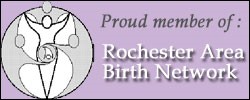Cultural Diversity in Childbirth Education
Amy V. Haas, BCCE
I had just started a new class and as I looked around the room I wondered what surprises these families would hold for me. How could I best help them find what they need? Most important, what would I learn from them?
As a childbirth educator (CBE) of 15 years I have learned to tailor my classes to accommodate the needs of different families. Just because I live in a suburb of a small city in upstate New York does not mean I will only have white, middle-class students. The area where I live is actually quite diverse, mimicking the population of the country as a whole. I must be careful not to assume that we all think or live alike. I have had the honor of teaching Amish families, lesbian partners, Orthodox Jews, devout Christians, polyamorous families and families of differing ethnicities.
I have learned that childbirth photos and films that include nudity may be offensive to some of the more conservative religious families. Certain cultures may have dietary aspects that need to be taken into account. Language needs to be appropriate for the broadest spectrum of the population, and tailored as necessary. Also, certain subjects might not be appropriate for all groups. In other words, consider your audience as best you can before each group you work with.
Having had both devout Christian and Orthodox Jewish families in my classes, I came to realize that photos of nude women giving birth might be considered offensive, especially in mixed gender classes. One Orthodox Jewish woman had to bring a doula with her to class because her husband was not allowed to be among other women or see nude pictures. At the birth he faced the wall and prayed but could not be at her side.
When a devout Christian family objected to nude photos, I started warning my students ahead of time about the type of photos they might see. Now, when I hold up a copy of Making Love During Pregnancy by Bing and Coleman, I say, “This book contains pencil drawings of naked couples making love. If you are offended by things like this you might not want to borrow it.” This inevitably results in laughter. Hopefully it also brings an understanding that not everyone shares the same mores.
I have also discovered that Celtic references and chanting monks are considered satanic by some Christian groups. While I might not understand this, since chanting monks are the oldest form of Christian music, I no longer use that type of music in classes.
One day I found myself arguing with a conservative Jewish woman about whether or not it was okay for her to fast on Yom Kippur. Ultimately I referred her to her medical care provider and her rabbi. It is not my place to do more than caution about fasting. I blamed it on Dr. Brewer, saying he strongly cautioned against skipping any meals.
When discussing diet with a woman from China, I stressed that the traditional Chinese diet was excellent and that, no, she did not have to adopt the standard American food choices. I did go into details of how to adapt the typical Chinese diet to meet the needs of a pregnancy. But other than increasing protein and variety there wasn’t much to change.
I have had both lesbian and polyamorous families in my classes. This has led to a change of language. Bradley classes are traditionally called “husband-coached.” I have learned to substitute the word partner. Frankly, I like it better. It’s also more respectful for women who do not have a male partner and instead bring a friend, family member or doula to class.
I do confess that when I had a polyamorous family (one man, two women) and a devout Christian family in the same class series, I called up the polyamorous family to warn them. They assured me they were discrete. None of us wanted antagonism in class. It might not have been fair, but it allowed everyone to concentrate on why we were there rather than focusing on individual family structures.
I have found when working with Amish families that certain topics are not appropriate to discuss. A friend of mine was working in a birth center that mostly cared for Amish women. At one point she tried to recommend the wonderful film Orgasmic Birth and discuss the occurrence of orgasm during birth with some of the women. She was surprised to discover that the Amish found this offensive, and it inevitably caused a rift between her and her co-workers. Remember to tailor your choice of topic for your audience. You might have to be creative in how you explain things, but if you give it some thought you can probably figure out a less stressful way of getting to your point.
If you are going to work with the general population, then you will inevitably run into people who are different from you. Get to know them better. Don’t make assumptions or judgments, and try to use clear language. Thank them for letting you know more about them. Be respectful, regardless, and remember why we’re here—to serve women. All women.
[As seen in issue #97 of Midwifery Today]
Amy Vater Haas has been a childbirth educator, writer, consultant and lecturer in the field of pregnancy and birth for the last 27 years. She was also the Education Chair for Rochester Area Birth Network. She lives outside of Rochester, New York, with two great teenage sons, a very patient husband and one demanding Chinook dog.
Amy V. Haas & Midwifery Today®2011 -2023



Follow Us!